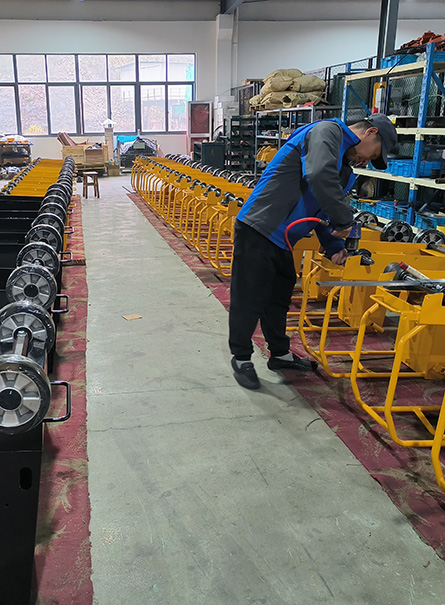What is a Concrete Vibrator?
Concrete vibrators, key in construction variety, come in myriad forms and power sources. Some models are small and battery-driven, others large, powered by electricity. Selecting the right concrete vibrator is crucial for concrete stability and durability.
How Does a Concrete Vibrator Work?
Concrete, when poured, inherently entraps numerous tiny air bubbles. The presence of these bubbles can significantly undermine the concrete's structural robustness once it hardens. Employing a concrete vibrator is a strategic move to vigorously agitate freshly poured concrete, effectively eliminating these air pockets and enhancing the concrete's strength.
Why Use a Concrete Vibrator?
The role of concrete vibrators is integral to the longevity of concrete. During pouring, air bubbles form, creating potential weak spots. Vibrators expel these bubbles, ensuring a denser and stronger concrete. Proper use of vibrators is visible as air escapes from the wet concrete.
What Kind of Concrete Vibrator Do You Need?
Project size influences the choice of concrete vibrator. There's a wide range of types, each with unique head sizes. Internal vibrators are often chosen for their cost-effectiveness and maneuverability. High frequency concrete vibrators convert single-phase to three-phase energy, beneficial for large-scale projects, especially in commercial and transportation sectors.
External vibrators suit vertical structures requiring strong reinforcement. Internal gas vibrators are ideal where electricity is unavailable or risky, useful in areas like curbs and construction joints.
Vibratory screeds, known for their lightweight and ease of use, allow operation while standing, suitable for both large and small, indoor or outdoor projects.
How to Operating Concrete Vibrators?
- Immersion or Internal Vibrators
Immersion vibrators, a common tool in construction, require insertion into the wet concrete. While vibrating, it's crucial to maintain a vertical orientation to avoid uneven compaction and potential equipment damage.
Avoiding cold joints is essential, so immerse the vibrator tip at least 6 inches into the prior concrete layer.
Follow a systematic pattern for inserting the vibrator to ensure even compaction and air removal.
Cease vibrating once the concrete's surface becomes glossy and air release ceases, to prevent over-vibration.
Gradually withdraw the vibrator at about an inch per second to ensure effective air removal without over-vibrating.
- Form or Formwork Vibrators
For larger pours, use multiple formwork vibrators, spaced about 6 feet apart, to ensure thorough concrete agitation.
Ensure that the formwork can vibrate freely, possibly using a spring-loaded isolation device.
The vibrator heads should be fully submerged in the concrete, and not turned on until completely submerged.
Intensify vibration for low-slump, stiffer concrete types to achieve complete air elimination.
- Surface Vibrators
Surface vibrators, suitable for shallower concrete slabs, help achieve a smooth surface finish.
In deeper concrete, complement surface vibration with internal vibration for thorough compaction.
Select the appropriate type of surface vibrator, such as vibrating roller screeds or pan-type vibrators, based on your project requirements.
Use vibrators solely for agitation, not for positioning the concrete, to avoid uneven surfaces.
Is Vibrating Concrete Necessary?
Vibrating concrete is generally advisable for enhanced strength and is often a building code requirement. Ensure compliance with local building ordinances if you opt not to use a vibrator.
How Long Do You Need to Vibrate Concrete?
Typically, vibrating concrete should take about 5 to 15 seconds. If air bubbles persist, repeat the process until the concrete is bubble-free.
The practice of vibrating concrete is often not executed to its full potential. Ideal usage of an internal concrete vibrator involves withdrawing it gradually, preferably at around 1 inch per second. Continue this process as long as air bubbles persist during the removal of the concrete vibrator, indicating the need for further vibration.
In construction, there's a tendency to hasten this task for efficiency, potentially leading to structural weaknesses once the concrete sets. Conversely, prolonged vibration can cause separation of water and aggregates, impacting the concrete's strength and visual appeal.
Be Ready Before You Pour
Effective vibration of concrete requires both skill and experience. It's wise to have an additional concrete vibrator on hand in case of equipment failure. The concrete will not pause for technical issues. Insert the vibrator in a predominantly vertical position for optimal effectiveness.
Excessive bending of the vibrator can damage it. Also, avoid using the vibrator as a tool for placing concrete, as this can result in an uneven surface and other complications.
Follow the Proper Usage Steps
Before vibrating, confirm that the area hasn't been already treated by others. Fully immerse the vibrator head into the concrete, keeping it submerged for at least 10 seconds before activating the vibrator.
Withdraw the vibrator at a steady pace, ideally no faster than 3 inches per second, with 1 inch per second often yielding optimal results. Overlap the previous vibration radius with each insertion. The effective radius is generally four times the diameter of the vibrator tip. Cease vibrating when no more air escapes and the concrete surface becomes glossy.
Preventing Cold Joints
Avoid forcefully pushing the vibrator into the concrete to prevent entanglement with rebar. Ensure penetration into previously laid concrete layers to avert cold joints, which happen when a new concrete layer doesn't bond with an older, already set layer. The vibrator should penetrate at least 6 inches into the previous layer.
Don't Under-Vibrate
Pay special attention to low-slump concrete, which, due to its stiffness, necessitates more vigorous vibration. For smaller projects, a lightweight, portable vibrator might be sufficient. Alternatively, the use of self-consolidating concrete can negate the need for vibration.
Ordering Concrete Vibrators
For construction projects requiring concrete vibrators, consider reliable options like Oztec Concrete Vibrators, which offer custom Flexshaft lengths and durable steel heads for optimal performance. Contact DY Concrete Pumps to order Oztec vibrators tailored to your project needs.


